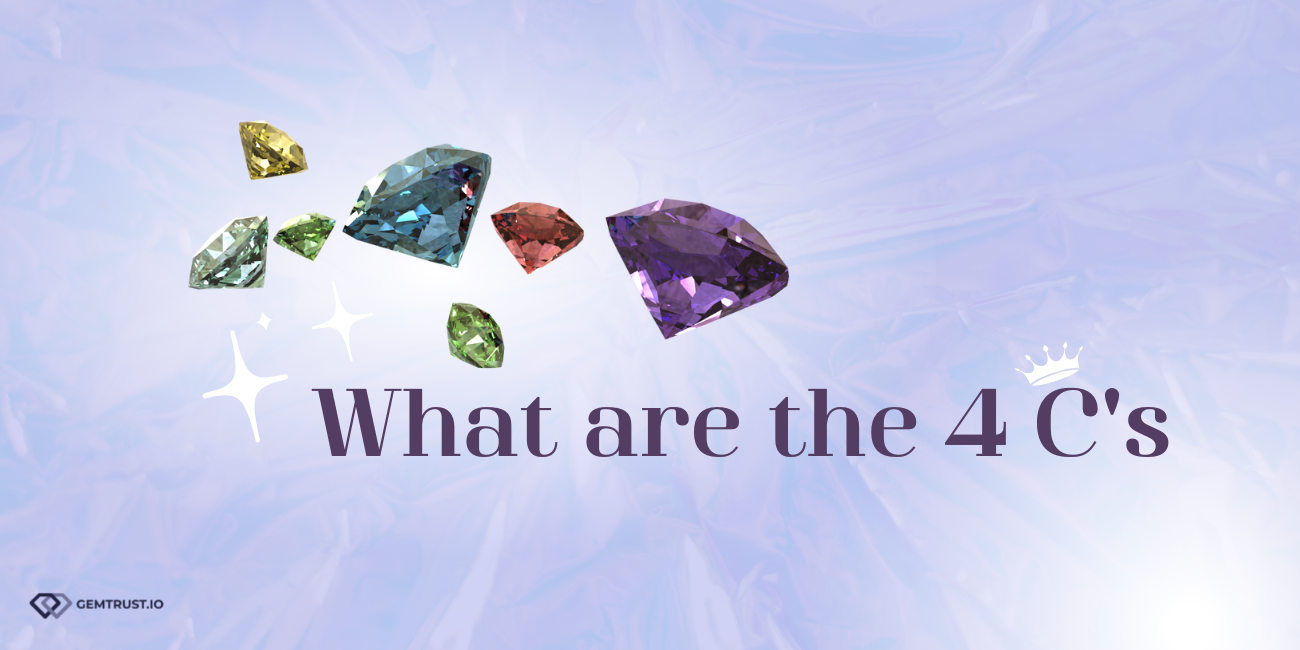
What are the Four C’s
The Four C’s
You may have often heard about the importance of the “Four C’s” when considering the purchase of a gemstone. The Four Cs are: Color, Clarity, Carat Weight, and Cut. Knowing the Four C’s will help you gain a better understanding of the precious jewel you desire. Let’s go over them one by one in order of their importance.
Color
Color is the most important attribute of a gem’s beauty and desirability. Color is everything. Even if a gem has inclusions or wasn’t cut properly, if the color is good the gem is valuable and is desirable.
(QIA009 Sri Lanka Blue Sapphire)
Color is the first aspect we notice when seeing a gem for the first time. The color should be pure and vibrant. There are seven primary colors: Red, Orange, Yellow, Green, Blue, Violet and Purple. The most valuable and desirable gem colors are those that are vivid and come within the range of one of these primary colors. You can use your imagination to picture what the purest and most vivid color is.
(AMI047 Green Octagon Emerald)
Think about the red in a traffic signal that stops you in your tracks! Or the lush deep green grass you saw at the golf course. Remember the beautiful vivid orange or yellow sunflower you saw at the florist shop? That is the power of color and its ability to evoke our senses.
(ASI0014 Bi-color Tourmaline)
More often than not though, even beautiful colors will contain a secondary hue. This means a gorgeous blue sapphire might carry a hint of violet or even green. Rubies of a pure and vivid red are exceedingly rare. Most rubies contain a tiny amount of purple or orange. Tourmalines have an incredibly wide range of colors. Although some tourmalines can be of a single primary hue, most are a blend of different colors including the famous Paraiba tourmaline.
Clarity
(VIV0013 Champaign Topaz)
After color, Clarity is the most important aspect of a gemstone’s quality, beauty, and desirability. Clarity refers to imperfections within a gem which affects its purity. Ideally, the cleanest and clearest gem is the most desirable. Think of pure water or a perfectly clear ice cube. Imagine a flawless crystal glass. But gemstones often contain very tiny amounts of materials such as pockets of gas or liquid, cavities, clouds and wisps, and needles, as well as fractures. Gems even frequently contain tiny crystals of other gems! Collectively, these internal materials are known as “inclusions”.
Inclusions are as old as the gemstone itself when it formed millions of years ago deep within the earth. In general, the fewer or smaller the inclusions, the greater a gemstone’s beauty, value, and desirability.
But inclusions can add to a gem's beauty, value, and desirability too! Long thin needle-like inclusions of a mineral called rutile are responsible for the beautiful stars seen on Star Sapphires or Star Rubies. These same rutile needle inclusions also cause the enchanting “Cat’s Eye” effect found in the very rare and mysterious Cat’s Eye Chrysoberyl.
(OCG0309 Amber with insect inclusion)
Other gems whose loveliness is caused by inclusions include Ammolite, Sunstone, Labradorite, Agates, and even Amber (whose insect and animal inclusions make it a very popular and unique collector gem). Another highly sought-after and highly valuable gem whose beauty is caused by inclusions is Opal. Tiny inclusions consisting of spheres of water are responsible for Opal’s stunning Iridescence or “play of color”. Star and Cat’s Eye effects, as well as other effects caused by inclusions such as play of color, are known as “Phenomena”.
Inclusions also play an important role in determining a gem’s provenance or origin. In many ways, inclusions are like fingerprints. Valuable and highly coveted gems like Burmese and Afghan rubies, Colombian and Afghan emeralds, and sapphires from Kashmir and Burma cannot be positively identified without knowing their inclusions.
Carat Weight
A “Carat” is a unit of weight that is used to determine the size of a gemstone. A carat is equivalent to 1/5 of a gram (and therefore equivalent to 200 milligram). When gems possess very fine color and clarity (or in the case of inclusions, phenomena) they are truly among the rarest of the rare even if carat-size in weight. However, if all characteristics such as color, clarity and overall quality remain the same as the gem gets bigger, the price of the gem increases dramatically. That is because gemstones of fine quality become much rarer in larger sizes. The bigger the gem (again, keeping in mind all things remain the same in terms of overall quality) the higher the price per carat.
For example, if a certain fine quality 1-ct ruby is valued at $3,000, a 2-ct ruby of similar quality will be valued at $5,000 per carat (or $10,000 for the stone).
(Weighing gemstones)
A 3-ct ruby of similar quality would be valued at $10,000 per carat (or $30,000 for the stone) whereas a 5-ct stone of similar quality can be valued at $30,000 per carat or more and so on. It is not uncommon to see exceptional quality rubies of just 5-ct size selling for up to $1,000,000 and more even among highly experienced gem professionals.
Fine quality rubies, sapphires and emeralds are among the rarest materials on earth and whose sizes are limited by their rarity. Other gems such as Aquamarine, Tourmaline, Peridot and Topaz are much more common and thus can be found in larger sizes of fine to reasonable quality. A very fine quality 10-ct Aquamarine or Peridot is relatively easy to find and can be offered for $300 per carat whereas a 10-ct emerald of similar fine quality is one of Nature’s great rarities and can sell for well over $60,000 per carat!
Cut
(Facetting a gemstone)
The fourth and final C is “Cut”. Although rough gemstones (also known as “rough” or “crystals”) can be very beautiful and desirable, more often than not rough gemstones are cut and polished to bring out their truest beauty and value from deep within. The person who cuts and fashions gemstones is known as a Lapidary.
Lapidaries are highly skilled craftsmen who examine a rough gem with a close eye and with meticulous planning and slow and painstaking work transforms it into a jewel. Think of a large block of marble from which an artist must turn into a lovely sculpture. A rough gem is seldom uniform in quality. There may be parts within the crystal where the color is stronger and more vibrant than in other parts. One part of the crystal might be clean or less included whereas the other part is opaque or even cracked.
(Polishing Gemstones)
The lapidary must put into consideration all of these factors in order to bring out the rough stone’s truest beauty and value. Even the shape of the rough plays an important part in determining what the finished cut gem will look like. A lapidary’s work therefore is not easy and can be very stressful.
Imagine being asked to cut a million dollar rough sapphire. For every carat or milligram of rough material which is grinded away, tens of thousands of dollars can be lost and never to return. For this reason when it comes to extremely scarce and highly valuable gemstones sometimes the quality of the cut and proportions is seen as secondary while every effort is made to save precious material.
The Fifth C—“Certification”
We hope you enjoyed this article explaining the Four C’s. If you have any other questions about how gemstones are graded and evaluated, please do not hesitate to speak with one of our gemologists or sales consultants. Before we end however, there is another “C” which we feel is very important in the buying, selling, and collecting of fine gemstones today: This is the fifth C of Certification. It is important for any gemstone–especially the more costly stones—be independently examined and certified from a specialist gem testing laboratory.
(Example of Gemstone Certificate from AIGS)
Certification provides assurance that the jewel which you are planning to purchase is exactly what the seller says it is. Although there are many gem testing laboratories in Bangkok, the AIGS Thailand, GRS GemResearch Swisslab, and GIA are considered by dealers to be among the most reliable and having decades of experience.
Nasim Ahmad A.G.
Gemologist and Blog writer at GemTrust.io
Source
TAG 4 c’s, what is 4c’s, clarity, cut, color, carat, buy diamond, sell diamond, gems certificate, diamond certificate, how to buy gems, The Four C’s, The fifth Certification
